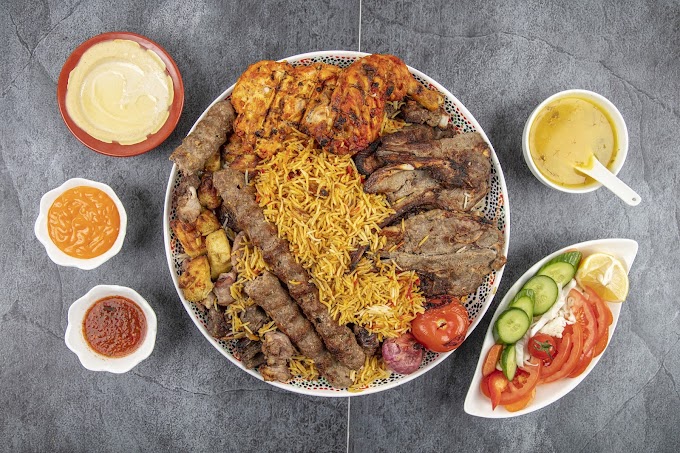Introduction: The Untold Story of Halal Street Food
Halal street food is one of the world’s most vibrant, diverse, and culturally rich culinary traditions — yet it often goes unnoticed in mainstream food media. From bustling Middle Eastern souqs to Southeast Asian night markets, halal street food tells stories of migration, trade routes, and centuries-old heritage.
What makes halal street food so special isn’t just the food itself. It’s the vendors who wake before dawn, the recipes passed down generations, and the way faith, culture, and flavor blend seamlessly in everyday life.
In this blog, we explore 10 hidden halal street food gems from around the world — dishes that deserve far more global attention than they get.
Let’s begin the journey.
1. Egypt – Koshari
The Vegan Halal King of Cairo
If there’s one street dish that defines Egyptian daily life, it’s koshari — a hearty, chaotic bowl of lentils, macaroni, chickpeas, rice, and crispy onions topped with spicy tomato vinegar sauce.
Why it’s a hidden gem:
Despite being Egypt’s national street food, koshari is strangely absent from most global food lists, even though it is one of the most affordable and flavour-packed halal dishes you can find.
Where to try: Downtown Cairo, especially near Talaat Harb.

2. Morocco – Maakouda
Golden Potato Fritters Loved Across the Maghreb
Maakouda is a Moroccan street favourite made from mashed seasoned potatoes shaped into patties and fried until crisp. It’s often eaten on the go or tucked into khobz (bread) with harissa.
Why it’s special:
Simple ingredients, big flavours — the essence of classic halal street culture.
Where to try: Fez medina or Marrakech souqs.
3. Saudi Arabia – Mutabbaq
The Stuffed Pancake Found Outside Every Mosque
Mutabbaq — a crispy stuffed pancake — is a Saudi street legend. Filled with minced meat, eggs, onions, or herbs, it’s folded and fried right in front of you.
Why it deserves attention:
It blends Yemeni, Indian, and Hejazi influences, reflecting the region’s trade and migration history.
Where to try: Jeddah’s Al-Balad district.
4. Pakistan – Bun Kebab
The Desi Burger with a Cult Following
Pakistan’s bun kebab vendors have perfected this nostalgic classic: a soft bun filled with a spiced patty (often lentils-meat blend), chutneys, onions, and a fried egg.
Why it’s a hidden gem:
It’s the South Asian equivalent of a street-style burger — but richer, spicier, and more soulful.
Where to try: Karachi’s Burns Road.

Photo by Rashida Hussain
5. Bangladesh – Fuchka
The Tangiest Street Snack in South Asia
Bangladeshi fuchka (similar to pani puri but punchier) is a crisp hollow puri stuffed with spicy mashed potatoes, tamarind water, and fiery chilli.
Why it’s unique:
Women vendors dominate the fuchka scene — a rare highlight in street food cultures.
Where to try: Dhaka’s Dhanmondi or Gulistan.

Photo by as.fawzia
6. Uzbekistan – Tandoor Somsa
The Silk Road Pastry with Smoky Layers
Uzbek somsa — baked in a clay tandoor — is one of Central Asia’s most iconic foods. Stuffed with lamb, beef, or pumpkin, it gets a uniquely smoky crispness.
Why it’s underrated:
While samosas are globally known, somsa is hardly talked about outside Central Asia.
Where to try: Samarkand street tandoor stalls.
7. Indonesia – Martabak Manis & Telur
The Night Market Favorite Loved by Millions
Indonesia’s martabak vendors attract queues every evening.
- Martabak Manis: Thick, sweet pancake filled with chocolate, cheese, or peanuts.
- Martabak Telur: A savoury, egg-filled stuffed flatbread bursting with spices.
Why it’s special:
One of the most beloved halal night snacks in Southeast Asia — yet globally underappreciated.
8. Singapore – Malay-Style Satay
Charcoal-Grilled Perfection at Hawker Centres
Malay satay stalls serve tender beef, chicken, or lamb skewers grilled over charcoal and served with peanut sauce and ketupat rice cakes.
Why it’s a hidden gem:
Tourists often flock to Chinese and Indian hawker stalls — overlooking deep-rooted Malay halal cuisine.
Where to try: Lau Pa Sat (Malay-run stalls), Geylang Serai, Kampong Glam.
9. Nigeria – Suya
West Africa’s Fiery Halal Street Grilled Meat
Suya is the pride of the Hausa Muslim community in West Africa. Thin slices of beef or chicken are marinated in yaji spice (peanut + chilli) and grilled roadside.
Why it stands out:
It’s smoky, spicy, addictive — and completely ignored by mainstream global food lists.
Where to try: Abuja, Kano, Lagos night streets.
10. USA – NYC Halal Cart Chicken Over Rice
The Immigrant-Driven Halal Street Revolution
What started with Egyptian street vendors serving taxi drivers in the 1990s has become a global halal staple.
Chicken over rice — with white sauce and fiery chilli — is now synonymous with “NYC street food.”
Why it's globally significant:
It represents Muslim entrepreneurship, diaspora culture, and the rise of halal food in the West.
Where to try: New York City street corners, especially Midtown.
Conclusion: A Global Journey Through Hidden Halal Flavours
Halal street food is more than just something to eat — it’s a living expression of culture, migration, and memory. These 10 dishes represent communities across Africa, Asia, and the West, each carrying stories often missing from mainstream food media.
If you’re a food lover, traveller, or blogger, this list is your invitation to taste the world through the halal lens — one street corner at a time.












.jpg)

